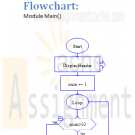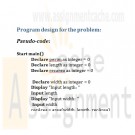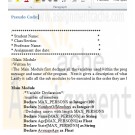Search results for 'capstone wee ones daycare'
-

CMIS 102 Assignment 2 build a state-of-the-art gaming computer
$12.00CMIS 102 Assignment 2 build a state-of-the-art gaming computer
Design a program to perform the following task:
Calculate the total price to purchase all the components required to build a state-of-the-art gaming computer from components available on the internet.[Hints: Before attempting this exercise, be sure you have completed all of chapter 3 and course module readings, participated in the weekly conferences, and thoroughly understand the examples throughout the chapter. As before, there are 3 main components of your submission including the problem analysis, program design and documentation, and sample test data.]
Part 1: Analysis [5 points]
Using a similar approach as example 3.6 (textbook page 146): “A new Car Price Calculator”, provide your analysis for the following problem statement: You need to write a program that will calculate the total price to purchase all the components required to build a state-of-the-art gaming computer from newegg.com. You will need to conduct some analysis on newegg.com (or amazon.com) regarding the possible options and prices to be considered. However; assume the computer will consist of the following components:CPU
Case
Power supply
Motherboard
Hard Drive
RAM
DVD
Sound Card
Monitor
Graphics Card
Operating SystemI would recommend you keep the option choices limited to 3 different components, or your program will really grow fast. For example, you could provide options for the Operating System (Windows 7, Red Hat Linux), the RAM (4 MB, 8 MB, 12 MB) and the Hard Drive Size (500 GB, 1 TB, 1.5 TB) and leave everything else as a baseline. I leave it up to you to determine which components you want to add options for and for researching the approximate prices. Be sure your prices are fairly realistic.
Your analysis should be clearly written and demonstrate your thought process and steps used to analyze the problem. Be sure to include what is the required output? What is the necessary input and how you will obtain the required output from the given input? Also, include your variable names and definitions. Be sure to describe the necessary formulas and sample calculations that might be needed.Part 2: Design [5 points]
Using a similar approach as example 3.6 (textbook page 146): “A new Car Price Calculator”, provide your program design for the program you analyzed for calculating the total price of your gaming computer. Be sure to describe the fundamental tasks (i.e., things your program must do) needed to solve the problem so you can use a modular design. Provide pseudocode of your overall design that includes the Main module and the order of the module calls (see page 148 for an example) and a Hierarchy chart for the computer price calculator (see figure 3.8 page 148). Finally, list all of your pseudocode for each module. (See pages148-150 as an example.)Include header and step comments in your pseudocode, using a similar approach as the example provided in section 2.3 (textbook page 86). See example 2.8 on pages 87-88).
Part 3: Test Data [3 points]
Learn More
Prepare at least 5 sets of input data (Test data) along with their expected output for testing your program. Your test data can be presented in the form of a table as was shown in Assignment 1. Be sure that you provide expected output for each test case. -

CMIS 102 Assignment 3 Repetition Statements multiplication table
$12.00CMIS 102 Assignment 3 Repetition Statements multiplication table
Write a program that would calculate and display the results for the multiplication table for values ranging from 1 to 100.
Before attempting this exercise, be sure you have completed all of chapter 4, 5 and course module readings, participated in the weekly conferences, and thoroughly understand the examples throughout the chapter. There are 3 main components of your submission including the problem analysis, program design and documentation, and sample test data.
1. Provide your analysis for the following problem statement: You need to write a program that would calculate the results for the multiplication table up from 1 to 100. (For example, 1X1, 1X2, 1X3 ... 1X10, 2X1, 2X2 ... 10X2 ... 10x10). Your program should print the output for each step and output a new line after 10 items. So the example output would be something like this Notice a new line appears after 10 steps:
1 2 3 4 5 6 7 8 9 10
2 4 6 8 10 ... 20
...
10 20 30 ... 100To write the new lines you can just use code similar to : write “new line”. Hint: You will probably use a nested repetition loop.
Your analysis should be clearly written and demonstrate your thought process and steps used to analyze the problem. Be sure to include what is the required output? What is the necessary input and how you will obtain the required output from the given input? Also, include your variable names and definitions. Be sure to describe any necessary formulas and sample calculations.
2. Provide your program design for the program you analyzed for printing the multiplication table. Be sure to describe the fundamental tasks (i.e., things your program must do) needed to solve the problem so you can use a modular design. Provide pseudocode of your overall design that includes the Main module and the order of the module calls, and a Hierarchy chart for the program (see figure 3.8 page 148). Finally, display the flow charts (using Raptor, or your favorite graphics editor) for each module. (See figure 5.3 page 233 as an example.)
Include header and step comments in your pseudocode, using a similar approach as the example provided in section 2.3 (textbook page 86). See example 2.8 on pages 88).
3. Prepare any input data (Test data) along with expected output for testing your program (Note: Programs may not always have both input and output data. Just provide test cases for your application). Your test data can be presented in the form of a table as was shown in Assignment 1.
Learn More -

CMIS 102 Assignment 4 Functions Calculate Perimeter of a Rectangle
$12.00Assignment 4 Functions Calculate Perimeter of a Rectangle
In this assignment, you will design a program to perform the following task:
Write a program, using functions, that calculates the area and perimeter of a rectangle whose dimensions (length and width) are provided by a user.Before attempting this exercise, be sure you have completed all of chapter 8 and course module readings, participated in the weekly conferences, and thoroughly understand the examples throughout the chapter. There are three main components of your submission, including the problem analysis, program design and documentation, and sample test data.
1. Provide your analysis for the following problem statement: You need to write a program that calculates the area and perimeter of a rectangle whose dimensions (length and width) are provided by a user.
Your analysis should be clearly written and demonstrate your thought process and steps used to analyze the problem. Be sure to include what the required output is. What is the necessary input and how will you obtain the required output from the given input? Also, include your variable names and definitions. Be sure to describe any necessary formulas and sample calculations.2. Provide your program design for the problem you analyzed for calculating and displaying the area and perimeter of a rectangle. Always work for modular design when possible. Be sure to use separate functions for calculating the area and perimeter of the rectangle. Other subprograms for Input and Output should be included as needed. Be sure to describe the fundamental tasks (i.e., things your program must do) needed to solve the problem so you can use a modular design. Provide pseudocode of your overall design that includes the Main module and the order of the module calls, and a Hierarchy chart for the program (see figure 3.8, page 148). Finally, display the flowcharts (using Raptor, or your favorite graphics editor) for each module. (See figure 5.3, page 225 as an example.)
Include header and step comments in your pseudocode, using a similar approach as the example provided in section 2.3 (textbook page 86). (See example 2.8 on pages 87–88.)
3. Prepare at least three sets of input data (Test data) along with expected output for testing your program. Your test data can be presented in the form of a table as was shown in Assignment 1.
Learn More -

CMIS 102 Final Project Average age of your family
$15.00CMIS 102 Final Project Average age of your family
Your final project will be to analyze, design, and document a simple program that utilizes a good design process and incorporates sequential, selection and repetitive programming statements as well as at least one function call and the use of at least one array. The specific problem you need to solve for the final project is: Design a program that will allow a user to Input a list of your family members along with their age and state where they reside. Determine and print the average age of your family and print the names of anyone who live in Texas.
Final Project Deliverables:
There are two deliveries for this project. The first delivery is the project plan which provides your problem statements, problem analysis, and how it will comply with the project specifications. The project plan is worth 10% of your grade. The final delivery will be your completed project design along with your code comments and comprehensive test plan. The final delivery is worth 20% of your grade.Your project plan is due in week 7 by midnight EST, on the specific date posted in the class schedule. The final delivery is due no later than the last day of class. Your instructor’s policy on late projects applies to this project.
Example Project Plan and Final Project template files, containing the required sections are included in the available resources. You should use this document to start your writing and fill in all of the details required.
Format:
Learn More
Project plan format and length:
The documentation describing your analysis and test plan should be written using Microsoft Word. The font size should be 12 point. The page margins should be 1 inch. The paragraphs should be formatted with double line or single line spacing. Any figures, tables, equations should be neatly labeled. All references should use APA style.



